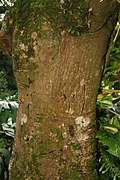Physical Description
provided by USDA PLANTS text
Perennial, Trees, Woody throughout, Nodules present, Stems erect or ascending, Stems greater than 2 m tall, Trunk or stems armed with thorns, spines or prickles, Stems solid, Stems or young twigs glabrous or sparsely glabrate, Leaves absent at flowering time, Leaves alternate, Leaves petiolate, Stipules conspicuous, Stipules green, triangulate to lanceolate or foliaceous, Stipules deciduous, Stipules free, Leaves compound, Leaves pinnately 3-foliolate, Leaves odd pinnate, Leaf or leaflet margins entire, Leaflets opposite, Stipels present at base of leaflets, Leaflets 3, Leaves glabrous or nearly so, Inflorescences racemes, Inf lorescence axillary, Inflorescence terminal, Bracts very small, absent or caducous, Bracteoles present, Flowers zygomorphic, Calyx 2-lipped or 2-lobed, Calyx glabrous, Petals separate, Corolla papilionaceous, Petals clawed, Petals red, Petals orange or yellow, Banner petal suborbicular, broadly rounded, Wing petals narrow, oblanceolate to oblong, Wing tips obtuse or rounded, Keel petals fused on sides or at tip, Stamens 9-10, Stamens diadelphous, 9 united, 1 free, Filaments glabrous, Style terete, Fruit a legume, Fruit stipitate, Fruit unilocular, Fruit tardily or weakly dehiscent, Fruit elongate, straight, Fruit oblong or ellipsoidal, Fruit exserted from calyx, Fruit compressed between seeds, Fruit torulose or moniliform, strongly constricted between seeds, Fruit beaked, Fruit glabrous or glabrate, Fruit 3-10 seeded, Seeds ovoid to rounded in outline, Seed surface smooth, Seeds olive, brown, or black.
Erythrina poeppigiana: Brief Summary
provided by wikipedia EN
Erythrina poeppigiana, called the mountain immortelle, is a species of flowering plant in the genus Erythrina, native to northern and western South America, and introduced to various places in Central America, the Caribbean, Africa, India and tropical Asia. Its striking display of orange flowers has led to its use as an ornamental street tree. It is the emblematic state tree of Mérida, Venezuela. Widely cultivated, it is a nitrogen fixer and a source of fodder.

In a natural setting

In a city setting

Blue-gray tanager

Red-crowned woodpecker

Stand

Trunk
- license
- cc-by-sa-3.0
- copyright
- Wikipedia authors and editors







